Jabalpur: Difference between revisions
ScrapIronIV (talk | contribs) Unsourced |
Tag: references removed |
||
| Line 446: | Line 446: | ||
The Jabalpur [[Cantonment]] is one of the largest in India.<ref>{{cite web |url=http://canttboardjabalpur.org.in/ |title=Jabalpur Cantonment Board |publisher=Jabalpur Cantonment Board |accessdate=7 April 2014}}</ref> |
The Jabalpur [[Cantonment]] is one of the largest in India.<ref>{{cite web |url=http://canttboardjabalpur.org.in/ |title=Jabalpur Cantonment Board |publisher=Jabalpur Cantonment Board |accessdate=7 April 2014}}</ref> |
||
Saint Aloysius Institute Of Technology |
|||
==Education== |
|||
{{main article|List of educational institutions in Jabalpur}} |
|||
{{Gallery |
|||
|title=Engineering institutions and their types |
|||
|width=250 |
|||
|height=250 |
|||
|lines=3 |
|||
|align=center |
|||
|File:Iiitdmj-campus.jpg|[[Indian Institute of Information Technology, Design and Manufacturing, Jabalpur|IIITDM Jabalpur]], a central government-funded institute |
|||
|File:Jabalpur Engineering College (JEC)'s Admin Building.jpg|[[JEC Jabalpur]], a state government-funded institute |
|||
|File:Lakshmi Narain College of Technology, Jabalpur (LNCT Jabalpur)'s Main Building.jpg|[[Lakshmi Narain College of Technology, Jabalpur|LNCT Jabalpur]], a private institute |
|||
}} |
|||
Jabalpur became a centre of higher education by the end of the 19th century, with institutions established by local citizens (such as the [[Hitkarini Sabha]],<ref>Allen's Indian mail and register of intelligence for British and foreign India Published 1870</ref> founded in 1868) and the British (such as [[Robertson College Jabalpur|Robertson College]], which began as a school in Sagar in 1836 and moved to Jabalpur in 1873).<ref>Madhya Pradesh Through the Ages, edited by Shiri Ram Bakshi, S.R. Bakshi And O.P. Ralhan, p. 20</ref> [[Jabalpur Engineering College]] was the first technical institution in central India established by the British. Scholars, authors and politicians such as [[Ravishankar Shukla]], [[Rajneesh]], [[Maharishi Mahesh Yogi]] and [[Gajanan Madhav Muktibodh]] have emerged from the Hitakarini institutions. The [[Indian Institute of Information Technology, Design and Manufacturing, Jabalpur]] (IIITD&M) was founded in 2005. |
|||
Jabalpur also is famous for Medical Education where it hosts a Govt. Medical College named as Netaji Subash Chandra Bose Medical college. |
|||
== {{anchor|Notable people}}Notable residents == |
== {{anchor|Notable people}}Notable residents == |
||
Revision as of 13:16, 20 July 2017
Jabalpur | |
|---|---|
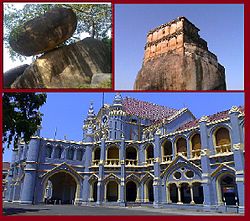 | |
| Nickname(s): Marble City, Sanskaardhaani | |
| Coordinates: 23°10′N 79°56′E / 23.167°N 79.933°E | |
| Country | |
| State | Madhya Pradesh |
| District | Jabalpur |
| Government | |
| • Type | Mayor–Council |
| • Body | Jabalpur Municipal Corporation |
| • Mayor | Swati Godbole |
| • District Magistrate | Mahesh Chandra Choudhary |
| • Municipal commissioner | Commissioner |
| • MP | Rakesh Singh |
| Area | |
| • Metropolis | 374 km2 (144 sq mi) |
| Elevation | 412 m (1,352 ft) |
| Population | |
| • Metropolis | 1,081,677 |
| • Rank | 40th |
| • Density | 478/km2 (1,240/sq mi) |
| • Metro | 1,267,564 |
| • Metro rank | 37th |
| Demonym(s) | Jabalpurians, Jabalpuriya, Jabalpurites |
| Time zone | UTC+5:30 (IST) |
| PIN | 482001 to 482011 |
| Telephone code | +91-761 |
| ISO 3166 code | IN-MP |
| Vehicle registration | MP-20 |
| Sex ratio | 929 ♂/♀ |
| Average Literacy Rate | 79.13% |
| Official language | Hindi |
| Website | www www |
Template:Contains Indic text Jabalpur (formerly Jubbulpore) is a tier 2 city in the state of Madhya Pradesh, India. According to the 2011 census, it is the third-largest urban agglomeration in Madhya Pradesh and the country's 37th-largest urban agglomeration.[3] It is 2nd largest metropolis of Central India after Raipur which is followed by Jabalpur, Bhopal, Bilaspur, Indore and Durg-Bhilai.
Jabalpur is the administrative headquarters of Jabalpur district (the second-most-populous district in Madhya Pradesh) and the Jabalpur division. Historically, a centre of the Kalachuri and Gond dynasties, the city developed a syncretic culture influenced by intermittent Mughal and Maratha rule. During the early nineteenth century, it was annexed by British India as Jubbulpore and incorporated as a cantonment town. Since Indian independence there have been demands for a separate state of Mahakoshal, with Jabalpur its capital. The High Court of Madhya Pradesh, headquarters of the West Central Railway and Army headquarters of five states (Madhya Pradesh, Chhattisgarh, Orissa, Bihar and Jharkhand) are located in Jabalpur. The city is also home to the Gun Carriage Factory.
Jabalpur has been selected as one of the hundred Indian cities to be developed as a smart city under Smart Cities Mission.[5] Bheraghat is a unique experience where one can see a huge mountains of marbel and a beautiful waterfall.
Etymology
The city's name is derived from the legendary sage Jaabaali, who is mentioned in the Ramayana, and may refer to Jaabaali's tapasya-bhoomi (place of penance). According to Bheegnari folklore, a small cave on the bank of the Narmada River was Jaabaali's ashram. Variations of the name include Jabalipuram and Jubbulgarh, and under British rule the city was known as Jubbulpore. In 2006, the Jabalpur Municipal Corporation renamed the city jabalpur [6]
History
Mythology describes three asura (evil spirits) in the Jabalpur region who were defeated by Shiva.[7] In Rupnath, 84 kilometres (52 mi) north of the city, Ashokan relics dating to 300 BCE have been found as evidence of the Maurya Empire (322 to 185 BCE).[7] When the empire fell, Jabalpur became a city-state before it was ruled by the Satavahana dynasty (230 BCE to 220 CE). Local rulers, including the Bodhis and the Senas, followed before the region became a vassal state of the Gupta Empire (320 to 550).[7]
From 675 to 800, the region was ruled by Bamraj Dev of the Kalachuri dynasty from Karanbel. The best known Kalachuri ruler was Yuvraj Dev I (reigned 915 to 945), who married Nohla Devi (a princess of the Chalukya dynasty). One of the Kalachuri amatya (ministers) was Golok Simha Kayastha, who was instrumental in founding the Chausath Yogini Temple near Bhedaghat. His descendants include Bhoj Simha, Diwan to Sangramsahi (reigned 1491–1543); Diwan Adhar Simha, Prime-minister to Rani Durgavati (reigned 1550–1564) and Beohar Raghuvir Sinha, Last jagirdar of Jabalpur until 1947.
Gondwana rulers

The Gondwana king, Raje Madan Shah Madawi of Mandla, (reigned 1138 to 1157 CE) built a watch tower small hilltop fort at Madan Mahal, an area in Jabalpur. In the 1500s, the Gond king, Sangram (whose son Raje Dalpat Shah Madawi married Rani Durgavati) held Singaurgarh fort in Sangrampur (near Garha, Jabalpur). Rani Durgawati was a brave warrior of Gond Dynasty, famous for her prosperous kingdom, she was well aware of the importance of water conservation hence she built more than 85 ponds in Jabalpur, mainly Ranital, Haathital, Madhatal, Hanumantal.
In 1564, during the reign of Veer Narayan (Sangram's grandson), Abdul Majeed Harawi (viceroy of Kara-Manikpur in the Mughal Empire) conquered Jabalpur and its surrounds. However, the Mughal supremacy in Jabalpur was more nominal than real.
In 1698, the Gondwana king, Raje Hriday shah (reigned 1652 to 1704) moved his court to the Mandla fort. He secured water sources and built irrigation structures. The Gondwana occupied by Nizam (reigned 1753 to 1780). After Nizam, the Gondwana kingdom fell to the Maratha.
Maratha
The Maratha rulers of Sagar, Madhya Pradesh came to power in about 1781. Around 1798, the Maratha Peshwa (governor) gave the Nerbuddah valley to the Bhonsle kings of Nagpur, who ruled the area until 1818 when it was taken by the British East India Company after the Battle of Sitabuldi.
The British Raj and the 1857 rebellion
Under the British Raj, the name Jabbalgarh became Jubbulpore and the town was made the capital of the Saugor and Nerbudda Territories (part of the North-Western Provinces governed by the Agra Presidency.) Jabalpur was known for Thuggee murders, which were combated by William Henry Sleeman (later appointed chief commissioner at Jubbulpore and then British Resident at Lucknow). On 16 June 1857, in the cantonment of Jubbulpore, sparking a rebellion. 1857 movement was started by the Gondwana king, Raje Shankar shah Madawi and the prince kunwar Raghonath shah madawi. Both were arrested and imprisoned. 18 September 1857 both were killed by the British.
Late 19th century
In 1861, the Saugor and Nerbudda Territories became part of the new Central Provinces and in 1903, the Central Provinces and Berar. In the early 1900s, Jubbulpore became the headquarters of a brigade of the Fifth Division of the Southern Army. A gun carriage factory was established in Jabalpur in 1904.
Gandhi era
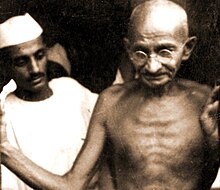
Mahatma Gandhi's longest stay in Jubbulpore was in 1933 at the Beohar palace of Beohar Rajendra Simha. Gandhi was accompanied by Jawaharlal Nehru, Vallabhbhai Patel, Khan Abdul Ghaffar Khan, Ravishankar Shukla, Vishnu Dayal Bhargava, Mukhtar Ahmed Ansari, Khurshed Nariman, Abul Kalam Azad, Jamnalal Bajaj, Syed Mahmud and Mahadev Desai.
Many freedom fighters joined Gandhi's three-S (Swadeshi, Swaraj and satyagraha) movements. Those from Jubbulpore included Vishnu Dayal Bhargava, Beohar Rajendra Sinha, Ravishankar Shukla, Sunderlal Tapasvi, Thakur Laxman Singh Chauhan, Seth Govind Das, Harihar Vyas, Maheshdatt Mishra, Deviprasad Shukla, Subhadra Kumari Chauhan, Hukumchand Narad, Makhanlal Chaturvedi, Balmukund Tripathi, Dwarka Prasad Mishra, Kunjilal Dubey, Narsinghdas Agrawal, Rameshwarprasad Guru, Bhawaniprasad Tiwari, Kavi Indra Bahadur Khare, Kashiprasad Pandey, Nathuram Vyas, Chidambaram Pillai, Sawaimal Jain, Satyendra Mishra, Sitaram Jadhav and Mulayamchand Jain.
In 1939, the Tripuri Congress session was chaired by Subhas Chandra Bose. The Swaraj movement was begun under the direction of Lokmanya Tilak. A Congress session was held at Vishnudatt Shukla Nagar at TilwaraGhat (near Jubbulpore) in 1939, when Subhas Chandra Bose was elected the Congress President over Gandhi's objections.
After independence

Gandhi's remains were brought to the city after his death. On 12 February 1948, the urn containing his ashes was immersed in the Narmada River at Tilwara Ghat by Ravishankar Shukla, Beohar Rajendra Sinha, Seth Govind Das and others.
In 1950, the Central Provinces and Berar became the state of Madhya Pradesh, and Shukla became the first chief minister of a congress led government. In 1956, Madhya Bharat, Vindhya Pradesh and Bhopal were merged into Madhya Pradesh state. Jubbulpore became Jabalpur and was chosen to be the state capital but at the last moment due to political pressure Bhopal became the state capital. [8] [9]
Demographics
| Year | Population |
|---|---|
| 2011 | |
| 2012 | |
| 2013 | |
| 2014 | |
| 2015 | |
| 2016 |
In the 2011 India census, the Jabalpur city (the area covered by the municipal corporation) recorded a population of 1,081,677.[2] The Jabalpur metropolitan area (urban agglomeration) recorded a population of 1,268,848.[3]
Civic administration
In 2011, Jabalpur covered an area of 53 square kilometres (20 sq mi). The Jabalpur municipal corporation, the JMC, is charged with governance of the city's civic and infrastructural assets. The corporation has two wings: deliberative and executive. The head of the executive wing is a municipal commissioner who is responsible for the corporation's day-to-day operation and assists the deliberative wing in the decision-making process. The JMC council has one elected representative (corporator) from each ward. Council elections, by popular vote, are held every five years. A corporator from the majority party is selected as mayor.
Jabalpur contributes one member to the Lok Sabha; its current member is Rakesh Singh of the Bharatiya Janata Party. The city sends eight members to the State Legislative Assembly: four from the city (Jabalpur Purba, Jabalpur Uttar, Jabalpur Cantonment and Jabalpur Paschim) and four from rural areas of the district. Jabalpur is divided into eight zones, each consisting of several wards.
Arts and culture
This section relies largely or entirely upon a single source. (September 2015) |
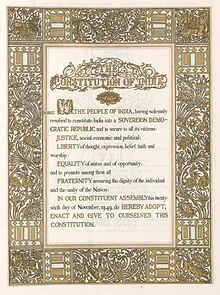
Jabalpur has been called Sanskaar Dhani (the cultural capital of Madhya Pradesh) by Vinayak Narhari Bhave; Bhopal is Raj Dhani (the state's political capital) and Indore is Vanijya Dhani (its commercial capital). Cultural figures associated with the city include Beohar Rammanohar Sinha, Makhanlal Chaturvedi, Harishankar Parsai, व्यौहार राजेन्द्र सिंह[12], Subhadrakumari Chauhan, Kavi Indra Bahadur Khare, Seth Govind Das, Roopkumar Soni, Alakhnandan Sinha, Gyanranjan Shrivastava, Rehman, Prem Nath, Krishna Raj Kapoor, Arjun Rampal, Jaya Bachchan, Aadesh Shrivastava and Raghubir Yadav.
The Narmada River, Gondwana rule and the Kalachuri and Maratha dynasties made Jabalpur a Gondism[citation needed] and Hinduism-dominated area, although Mughal rule attracted a sizeable Muslim population. The city's Hindu-Muslim riots during the 1960s shook the confidence of Muslims in secular India.[13]
Jabalpur's culture is related to the agricultural population of the city and surrounding area. Food and clothing change with the harvest and season. The city has sizeable Gonds, Marwari, Bengali, Malayali, Sindhi, Tamil, Telugu, Kannadiga, Marathi, Punjabi people and Baniya people populations. The Navratri and Dusshera festivals are celebrated by residents and visitors from throughout the state.
Geography
India's central point is in the Jabalpur district. The city has an average elevation of 411 metres (1,348 feet).
Topography
Jabalpur's hills, with their variety of minerals, draw geologists and archaeologists. The city is surrounded by low, rocky, barren hillocks. Its primary reservoirs (Khandari and Pariyat) are northeast of the city, and water is also drawn from the Narmada River by the public-health department.
The main crops grown in the region are wheat, rice, pulses, oilseeds and maize. Bargi Dam, on the Narmada, is used for irrigation, water and power generation. Jabalpur is surrounded by several lakes and water tanks. The area is rich in limestone, refractory clay, bauxite, iron ore, manganese and other deposits, and there is some mineral-related industry in the area.
Climate
| Jabalpur | ||||||||||||||||||||||||||||||||||||||||||||||||||||||||||||
|---|---|---|---|---|---|---|---|---|---|---|---|---|---|---|---|---|---|---|---|---|---|---|---|---|---|---|---|---|---|---|---|---|---|---|---|---|---|---|---|---|---|---|---|---|---|---|---|---|---|---|---|---|---|---|---|---|---|---|---|---|
| Climate chart (explanation) | ||||||||||||||||||||||||||||||||||||||||||||||||||||||||||||
| ||||||||||||||||||||||||||||||||||||||||||||||||||||||||||||
| ||||||||||||||||||||||||||||||||||||||||||||||||||||||||||||
Jabalpur has a humid subtropical climate typical of north-central India (Madhya Pradesh and southern Uttar Pradesh). Summer begins in late March, lasting until June. May is the hottest month, with the average temperature exceeding 45 °C (113 °F). Summer is followed by the southwest monsoon, which lasts until early October and produces 35 inches (889 mm) of rain from July to September. Average annual precipitation is nearly 55 in (1386 mm). Winter begins in late November, and lasts until early March. January is the coldest month, with an average daily temperature near 15 °C (59 °F).
| Climate data for Jabalpur | |||||||||||||
|---|---|---|---|---|---|---|---|---|---|---|---|---|---|
| Month | Jan | Feb | Mar | Apr | May | Jun | Jul | Aug | Sep | Oct | Nov | Dec | Year |
| Mean daily maximum °C (°F) | 24.5 (76.1) |
28.8 (83.8) |
34.3 (93.7) |
38.7 (101.7) |
40.4 (104.7) |
36.2 (97.2) |
30.3 (86.5) |
28.2 (82.8) |
30.9 (87.6) |
32.4 (90.3) |
29.7 (85.5) |
25.5 (77.9) |
31.7 (89.0) |
| Mean daily minimum °C (°F) | 8.5 (47.3) |
11.4 (52.5) |
16.2 (61.2) |
21.2 (70.2) |
24.4 (75.9) |
24.1 (75.4) |
22.6 (72.7) |
21.9 (71.4) |
21.1 (70.0) |
18.1 (64.6) |
13.9 (57.0) |
9.6 (49.3) |
17.7 (64.0) |
| Average precipitation mm (inches) | 22.2 (0.87) |
23.4 (0.92) |
15.5 (0.61) |
7.7 (0.30) |
12.9 (0.51) |
167.3 (6.59) |
421.9 (16.61) |
422.9 (16.65) |
200.1 (7.88) |
39.9 (1.57) |
15.0 (0.59) |
9.9 (0.39) |
1,358.7 (53.49) |
| Average precipitation days | 0.8 | 0.8 | 0.3 | 0.3 | 1.8 | 8.6 | 15.9 | 18.3 | 8.6 | 3.1 | 1.4 | 0.6 | 60.5 |
| Mean monthly sunshine hours | 288.3 | 274.4 | 288.3 | 306.0 | 325.5 | 210.0 | 105.4 | 80.6 | 180.0 | 269.7 | 273.0 | 282.1 | 2,883.3 |
| Source: HKO | |||||||||||||
Economy
Agriculture
The Narmada River, draining the Satpura and Vindhya Ranges, has developed an agrarian economy in the district. The river originates in the northeastern Satpura Range and flows west between the ranges towards the Arabian Sea. The Narmada basin's alluvial soil produces sorghum, wheat, rice and millet in the villages around Jabalpur.
Commercial crops include pulses, oilseeds, cotton, sugar cane and medicinal crops. During the early 20th century the region became a centre of the beedi industry, when brothers Mohanlal and Hargovindas Patel discovered that tendu leaves were good for making beedies.
Ordnance factories
Vehicle Factory Jabalpur, Grey Iron Foundry, Gun Carriage Factory Jabalpur and the Ordnance Factory Khamaria manufactures bullets, howitzers, rockets, bombs, mortars, grenades, shells, trucks, mine-protected vehicles and bulletproof vehicles for the Indian Armed Forces, the paramilitary forces of India, the Central Armed Police Forces, State Armed Police Forces and the Special Forces of India. These companies are the city's primary employers. Allied organisations are the Directorate General of Quality Assurance (DGQA), responsible for the quality of equipment manufactured by the ordnance factories; the Central Ordnance Depot, which stores and supplies equipment and weapons for the armed forces; the 506 Army Base Workshop, which maintains equipment for the armed forces and the Defence Security Corps, responsible for guarding the ordnance factories. These organisations alone employ over 100,000 people.[citation needed]
Defence organisations
In addition to the ordnance factories, army formations and organisations include HQ Madhya Bharat Area, the Jammu & Kashmir Rifles Regimental Centre, the Grenadiers Regimental Centre, 1 Signal Training Centre, College of Material Management, Central Ordnance Depot, 506 Army Base Workshop, Military Hospital, HQ Chief Engineer Jabalpur Zone, Military Dairy Farm and HQ Recruiting Zone. Civilian organisations which are part of the Ministry of Defence are the Cantonment Board, Controller of Defence Accounts, Defence Standardisation Cell and the Canteen Stores Department.
Division headquarters
Jabalpur is a division headquarters for eight districts: Jabalpur, Seoni, Mandla, Chhindwara, Narsinghpur, Katni, Dindori and Balaghat. The district, which was reconstituted on 25 May 1998, has four tehsils: Jabalpur, Sihora, Patan and Kundam. The city is the headquarters of the Madhya Pradesh State Electricity Board, the Homeguards and other state and central-government offices.
Industry
Major industries in Jabalpur are garment manufacturing, IT, education, electrical goods, limestone products, building materials, glassware, telephone parts, furniture, foodstuffs, steel structures, cement, tobacco products, industrial-safety goods, mechanical engineering and cinema. Now Jabalpur is being Film Making Zone & Music Industries is Growing. [citation needed]
Transportation
Air

The 310-acre (130 ha) Jabalpur Airport (JLR), also known as Dumna Airport, is about 20 kilometres (12 mi) from the city centre and flight services are provided by Air India and SpiceJet. Daily service is available to New Delhi, Mumbai, Hyderabad, Bhopal. The Spice Jet offers daily service to Hyderabad, Mumbai and New Delhi, whereas Air India offers services to New Delhi, Hyderabad, Mumbai, Bhopal. Jabalpur Airport serves visitors to Kanha National Park, Bandhavgarh National Park, Pench National Park, Khajuraho and Bhedaghat.
| Airlines | Destinations |
|---|---|
| Air India Regional | Bhopal, Delhi, Hyderabad |
| SpiceJet | Delhi, Hyderabad, Mumbai |
Rail

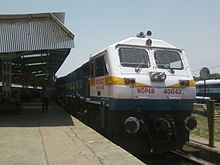
Jabalpur Junction railway station, headquarters of the West Central Railway, has direct service to Mumbai, New Delhi, Chennai, Kolkata, Ahmedabad, Hyderabad, Bangalore, Nagpur, Surat, Pune, Patna, Ludhiana, Jammu, Vasco-Da Gama, Amravati, Coimbatore, Bhopal, Indore, Gwalior, Agra, Jaipur, Varanasi, Kanpur, Vadodara, Bhubhaneshwar, Lucknow, Puri, Allahabad, Nasik, Rajkot, Guwahati, Ambikapur, Bilaspur, TataNagar & Raipur.
The conversion of narrow-gauge track in the Gondia-Nainpur-Jabalpur corridor to broad gauge has begun; this will facilitate access to areas of southern India. This is expected to be completed by 2018. The line from Gondia to Balaghat & Jabalpur to Ghansore has been converted to broad gauge with daily passenger services.
Jabalpur was the terminus of Indian Railways train number 1: the Satpura Express, re-numbered Train No. 10001 in the five-digit numbering system, this train has closed due to up-gradation to broad gauge.
In addition to the Jabalpur Main Station, the city's Madan Mahal Station serves inner-city passengers and the Kachhpura goods shed transports heavy freight and iron ore to port cities. A Jabalpur metro rail project is proposed for the metropolitan area.
Important that origins from here :
- 12061/Bhopal Habibganj - Jabalpur Jan Shatabdi Express
- 12121/Madhya Pradesh Sampark Kranti Express
- 12187/Jabalpur - Mumbai CST Garib Rath Express
Road
Jabalpur is connected by road to Varanasi, Nagpur, Bhopal, Jaipur, Raipur, Allahabad, Hyderabad, Bilaspur and Bangalore. India's longest national highway, National Highway 7, runs through the city and National Highway 12 to Jaipur originates in Jabalpur. Many roads are being upgraded to four-lane highways. Bus service is available to cities in Madhya Pradesh, Maharashtra and Chhattisgarh, with direct service to Indore, Nagpur, Bhopal, Varanasi, Raipur, Amravati, Chandrapur and Allahabad.
Telecommunications
Jabalpur is covered by a network of optical fibre cables. Landline services are offered by four landline companies namely BSNL, Reliance, Airtel & Tata Indicom.
2G/3G mobile voice & data services are offered by BSNL, Idea, RCom, TataDocomo, Vodafone & Airtel.
4G mobile & wifi data services are being operated by RelianceJio, Airtel, Idea & RCom.
High Speed broadband internet services are also available from operators like BSNL, Airtel, MTS, Tikona etc.
Media
Several television news channels have branches in the city. Various cable operators operate digital cable TV system in city.[14]
Newspapers
National and local newspapers are published in Jabalpur in Hindi and English:
| Newspaper | Language | Founded |
|---|---|---|
| NaiDunia | Hindi | 1947 |
| Patrika | Hindi | |
| Nava Bharat | Hindi | 1934 |
| Deshbandhu | Hindi | 1959 |
| Hari Bhoomi | Hindi | 1996 |
| The Times of India | English | 1838 |
| Hindustan Times | English | 1924 |
| Hindustan | Hindi | |
| The Hitavada | English | 1911 |
| Business Standard | English, Hindi | 1975 |
| Dainik Bhaskar | Hindi | 1958 |
Radio
Radio stations in Jabalpur include:
| Name | Frequency (MHz) | Tagline |
| Red FM | 93.5 | Bajaate raho |
| MY FM | 94.3 | Jiyo Dil se! |
| Radio Mirchi | 98.3 | Its Hot! |
| Radio Dhamaal | 106.4 | Dhinchak |
| Akashvani | 102.9 | |
| Gyan Vani | 105.6 |
Akashvani Jabalpur broadcasts on 801 kHz AM with a 200 kW transmitter.
Tourism

Attractions in Jabalpur include:
- Hanumantal Bada Jain Mandir, a 17th-century Jain temple
- Madan Mahal, a fort built by the Gondi king Madansahi in 1116
- Rani Durgawati Museum, built in 1964 to commemorate Rani Durgavati. The museum hosts ancient relics, sculptures and a collection of items related to Mahatma Gandhi
- Dumna Nature Reserve Park. Good for birdwatchers. Animals are not seen. It houses Khandari Dam, which is a source of drinking water to the city and has many crocodiles.
- Bargi Dam Reservoir for boat rides
- Dhuandhar Falls and Marble Rocks in Bhedaghat, 15 kilometres (9.3 mi) from the city. Boat rides on Narmada river specially in moonlight, flowing through the breathtakingly beautiful Marble Rocks on both sides famous for many Bollywood movie climaxes to near the Dhuandhar falls are available. In the 45-minute ride the boatman describes the various spots in a singsong hilarious manner. He also tells the story of Bhura, the crocodiles and many that lurk downsream.
- Rani Durgawati Museum. Lamheta Ghaat, Kosam Ghaat, Tilwara Ghaat is Famous Ghaat Of Narmada River.
- Kachnar City, known for a 76-foot (23 m)-high Shiva statue housing a cavern with replicas of Shiva lingas from 12 shrines nationwide.[15]
- Tilwara Ghat, location of the Tilwadeshwar temple and where Gandhi's ashes were immersed
- Jilehri Ghat, a swimming and picnic spot
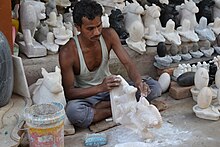
- Chounshath Yogni-Shiva Parvati Temple - Ancient hilltop circular Yogini temple with 64 Yogini sculptures
- Osho Ashram Supatal, where Rajneesh was enlightened
- Pisanhari Ki Madiya, a historic Jain pilgrimage near Netaji Subhash Chandra Bose Medical College[16]
- Nandishwardeep (Madiyaji):This Jain temple is considered as one of the profound and amazing temples in Central India in Modern times
Attractions within 200 kilometres (120 mi) include:
- Jageshwar Nath Shiv Temple at Bandakpur, near Damoh
- Kundalpur Jain Teerth Kshetra, near Damoha
- Vishnu-Varaha Temple, Majholi
- Pench National Park
- Kanha Tiger Reserve
- Bandhavgarh National Park
- Bhedaghat[1]
-
Hanumantal Bada Jain Mandir, Jabalpur, from across Hanumantal Lake
-
Madan Mahal fort
-
Shiv Statue at Kachnar City, Jabalpur
Sports
The Wright Town Stadium and Rani Tal Stadium are in the city. Snooker was invented in Jabalpur. Billiards was a popular activity amongst British army officers stationed in India (who derived it from the Indian game carrom), and variations on traditional billiard games were devised.
One variation added coloured balls to the reds and black used for pyramid and life pool; this became snooker. It is generally accepted that Colonel Sir Neville Chamberlain (no relation to the World War II prime minister) conceived the game in the British Army officer's mess in Jubbulpore, India in 1875.[17]
Local delicacy
Khoye ki Jalebi, is Jabalpur's local delicacy. Popular in Madhya Pradesh, it was invented by Harprasad Badkul in 1889 in his Badkul Halwai shop near the Kamaniya Gate.[18][19] It is said that his early experiments to create a jalebi from khoya failed until he added tekhur, which may be eaten by fasting people avoiding grain, as a stabiliser.
Jabalpur Cantonment
The Jabalpur Cantonment is one of the largest in India.[20]
Saint Aloysius Institute Of Technology
Notable residents
- Mahant Swami Maharaj
- Osho
- Rammanohar
- Subhadra Kumari Chauhan
- Rani Durgawati
- Prem Nath
- Harishankar Parsai
- Aadesh Shrivastava
- Arjun Rampal
- Rehman
- Prajakta Shukre
- Maharishi Mahesh Yogi
- Beohar Rajendra Simha [21]
- Raghubir Yadav
- Sharat Saxena
- K. S. Sudarshan
- Ajai Chowdhry
- Shreegopal Vyas
- Saurabh Sinha
- Jaya Bachchan
- Kamta Prasad Guru
- Vivek Sharma
- Shaleen Bhanot
- Jagmal Raja Chauhan
- Gurmeet Choudhary
- Chitrashi Rawat
- Haji Mohammed Mateen Khan (Mateen Kabadi)
See also
References
- ^ District Census Handbook, Indore
- ^ a b "Jabalpur district" (PDF). 2011 Census of India. Retrieved 20 October 2015.
- ^ a b c "Provisional Population Totals, Census of India 2011; Urban Agglomerations/Cities having population 1 lakh and above" (PDF). Office of the Registrar General & Census Commissioner, India. p. 3. Retrieved 26 March 2012.
- ^ "Presentation on Towns and Urban Agglomerations". Census of India 2011. Retrieved 13 March 2016.
- ^ http://www.firstpost.com/business/why-only-98-cities-instead-of-100-announced-all-questions-answered-about-smart-cities-project-2410576.html
- ^ "Now, Indore to become Indur, Bhopal Bhojpal". The Times of India. 18 December 2006.
- ^ a b c Jabalpur City Guide. Goodearth Publications, 2008 p8. ISBN 9788187780731.
- ^ https://www.quora.com/Why-was-Bhopal-Chosen-as-capital-of-Madhya-Pradesh-in-1956-instead-of-Indore-which-was-already-the-biggest-city-of-the-central-India-and-capital-of-Madhya-Bharat
- ^ http://www.patrika.com/news/madhya-pradesh/that-s-why-jabalpur-could-not-make-capital-of-mp-3323/
- ^ http://www.citypopulation.de/world/Agglomerations.html?cityid=2983
- ^ . Office of the Registrar General and Census Commissioner, India http://www.census2011.co.in/data/religion/district/318-jabalpur.html. Retrieved 29 November 2015.
{{cite web}}: Missing or empty|title=(help) - ^ https://hi.wikipedia.org/wiki/%E0%A4%B5%E0%A5%8D%E0%A4%AF%E0%A5%8C%E0%A4%B9%E0%A4%BE%E0%A4%B0_%E0%A4%B0%E0%A4%BE%E0%A4%9C%E0%A5%87%E0%A4%A8%E0%A5%8D%E0%A4%A6%E0%A5%8D%E0%A4%B0_%E0%A4%B8%E0%A4%BF%E0%A4%82%E0%A4%B9
- ^ Engineer, Asghar Ali. "Islam and Muslims in India: Problems of Identity and Existence". http://andromeda.rutgers.edu/~rtavakol/engineer. Rutgers University. Retrieved 19 September 2015.
{{cite web}}: External link in|work= - ^ "Jabalpur Media". Mapsofindia.com. Retrieved 1 September 2010.
- ^ "Jabalpur". Jabalpur Tourism Promotion Council. Jabalpur Tourism Promotion Council. Retrieved 19 April 2014.
- ^ "Pisanhari Ki Madiya". jabalpur.nic.in. Office of District Magistrate, Jabalpur, Madhya Pradesh. Retrieved 17 January 2016.
- ^ "The History of Snooker". Titansports.co.uk. Archived from the original on 17 December 2002. Retrieved 1 September 2010.
{{cite web}}: Unknown parameter|deadurl=ignored (|url-status=suggested) (help) - ^ Siddhantacharya Phulachandra Shastri, Parwar Jain Samaj ka Itihas, 1990, Jabalpur, p. 418
- ^ Sugar rush: TravelKhana to deliver sweets to train passenger, DNA, 18 Mar 2016
- ^ "Jabalpur Cantonment Board". Jabalpur Cantonment Board. Retrieved 7 April 2014.
- ^ https://hi.wikipedia.org/wiki/%E0%A4%B5%E0%A5%8D%E0%A4%AF%E0%A5%8C%E0%A4%B9%E0%A4%BE%E0%A4%B0_%E0%A4%B0%E0%A4%BE%E0%A4%9C%E0%A5%87%E0%A4%A8%E0%A5%8D%E0%A4%A6%E0%A5%8D%E0%A4%B0_%E0%A4%B8%E0%A4%BF%E0%A4%82%E0%A4%B9





